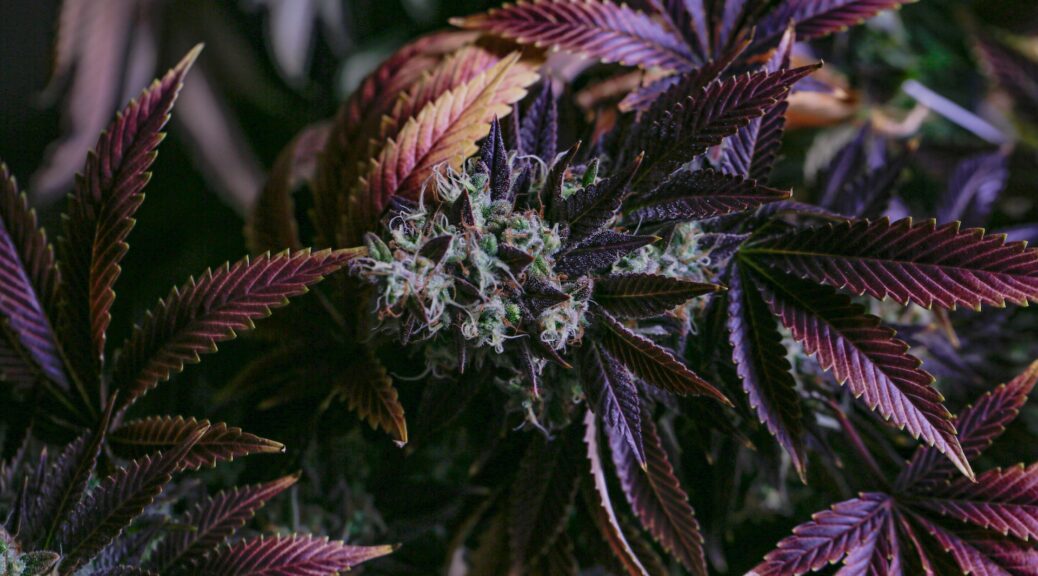You’re walking through a cannabis dispensary or browsing an online catalog, and you come across a variety of cannabis that stands out from the rest. Its buds are a deep, mesmerizing shade of purple, distinct from the usual greens and browns you’re accustomed to seeing. You might find yourself wondering, why is some weed purple?
Whether you’re a casual consumer, a medicinal user, or a cultivation enthusiast, taking a good look into the reasons behind the purple coloration of some cannabis strains can be enlightening. Numerous factors contribute to this colorful phenomenon, from the role of specific pigments like anthocyanins to the impact of temperature and light during growth.
Let’s dive deep into the mysteries of purple cannabis and discuss why some weed is purple.
Genetics of Purple Cannabis
The coloration of cannabis is typically determined by its genetics. Certain cannabis strains naturally possess a higher concentration of anthocyanins, leading to their purple hue. Popular purple strains include ‘Granddaddy Purple’ and ‘Purple Haze,’ each with unique genetic backgrounds contributing to their color.
Advanced breeding techniques have enabled cultivators to enhance these purple hues by crossing strains with strong color traits. Hybrid strains have further diversified the color palette available in cannabis. Moreover, the stability and inheritance of color traits in cannabis genetics are areas of ongoing research and interest, particularly since the demand for visually appealing strains has increased dramatically.
Related: Indica vs. Sativa vs. Hybrid: Choosing the Right Cannabis Strain
Environmental Impact on Cannabis Color
Environmental conditions play a pivotal role in the expression of color in cannabis. Temperature is particularly influential; cooler temperatures at the end of the growing season can intensify the purple pigmentation. Light exposure also affects color development, as specific wavelengths can stimulate or inhibit anthocyanin production.
Nutrient levels, especially nitrogen and phosphorus, and soil conditions, such as pH, can alter the plant’s coloration. Cannabis plants may exhibit color changes in response to environmental stressors, like drought or damage, as part of a protective response.
Harvesting and Processing Influences
The final color of cannabis is also affected by cultivation practices, particularly during the harvesting and curing processes. The timing of the harvest can influence the intensity of the color; too early or too late can diminish the vivid hues.
The curing process is crucial for preserving the color of the buds. Maintaining proper humidity and temperature during curing can prevent color degradation. The most experienced growers have developed special techniques to retain the color post-harvest.
Comparing fresh and cured buds will often show a notable difference in the intensity of the color. Growers seeking to maximize the visual appeal of their cannabis should consider these factors to grow visually appealing plants.
From the genetics that dictate color potential to the environmental factors that bring it to fruition, each aspect plays a crucial role in developing purple cannabis.
Related: What’s Your Favorite Color? Recommend a Strain for Beginners
Market Trends and Consumer Preferences
The allure of purple cannabis extends beyond its medicinal potential, significantly influencing market trends and consumer preferences. There’s a growing interest in unique cannabis colors, with many associating different exotic hues with superior quality and potency.
This trend has been bolstered by the prevalence of social media, where visually striking images of purple cannabis varieties often go viral, further fueling their popularity. In response, the cannabis industry has seen a surge in demand for such exotic cannabis strains.
Color has become a significant element in branding and marketing strategies within the cannabis industry, showcasing the importance of visual appeal in consumer choice.
The WeedColors Mobile App, an innovative platform, taps into this trend by allowing users to rate cannabis strains based on color, fostering a new way to categorize and appreciate cannabis. Download it today.
Cultivation Tips for Purple Varieties
For those interested in cultivating purple cannabis, the journey starts with choosing suitable strains, as genetics play a crucial role in determining a plant’s potential for developing purple hues.
Cultivators also need to optimize environmental factors such as temperature and light, which can significantly influence color development. Nutrient management is another critical aspect; specific nutrient formulations can enhance or diminish the plant’s natural colors.
Some growers employ stress induction techniques to trigger color change, but this must be done cautiously to avoid damaging the plant. Novice growers should be aware of common mistakes in cultivating purple cannabis to ensure the best results.
For enthusiasts looking to explore different strains, the Weedcolors App offers a comprehensive guide to understanding the nuances of cannabis flower flavors and colors, helping users make informed choices.
Dispelling Myths About Purple Cannabis
Despite the intrigue and popularity of purple cannabis, it’s essential to dispel certain myths surrounding it.
Many people believe that the potency of purple cannabis is much greater than green cannabis. Still, THC content is determined by genetics and how well the cannabis is cultivated rather than by the color it presents.
The myth that purple cannabis is inherently more expensive is also misleading; pricing is influenced more by quality, availability, and market demand.
Related: Best Daytime Strains for Productivity: Boosting Focus and Energy
Embracing the World of Colorful Cannabis
The exploration of purple cannabis not only reveals its aesthetic appeal but also underscores the importance of informed choices in the ever-evolving cannabis market. Understanding the factors that contribute to the color of cannabis, from genetics to cultivation practices, enhances appreciation for these beautiful varieties.
If you want to learn more about all the different types and strains of cannabis, download the WeedColors app, which provides a unique platform to explore, rate, and understand the diverse spectrum of cannabis strains available today.

